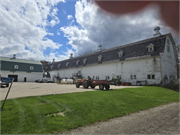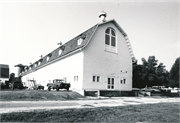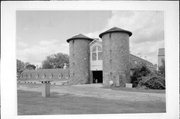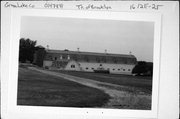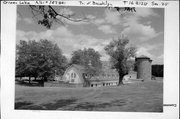Property Record
W2609 ABBEY RD
Architecture and History Inventory
| Historic Name: | LONE TREE FARM ESTATE GUERNSEY BARN |
|---|---|
| Other Name: | WILLIAM CAREY HALL |
| Contributing: | Yes |
| Reference Number: | 147841 |
| Location (Address): | W2609 ABBEY RD |
|---|---|
| County: | Green Lake |
| City: | |
| Township/Village: | Brooklyn |
| Unincorporated Community: | |
| Town: | 16 |
| Range: | 12 |
| Direction: | E |
| Section: | 25 |
| Quarter Section: | NE |
| Quarter/Quarter Section: | NW |
| Year Built: | 1916 |
|---|---|
| Additions: | |
| Survey Date: | 2007 |
| Historic Use: | barn |
| Architectural Style: | Astylistic Utilitarian Building |
| Structural System: | |
| Wall Material: | Drop Siding |
| Architect: | |
| Other Buildings On Site: | |
| Demolished?: | No |
| Demolished Date: |
| National/State Register Listing Name: | Not listed |
|---|---|
| National Register Listing Date: | |
| State Register Listing Date: |
| Additional Information: | A 'site file' titled "Upper Lone Tree Farm Estate Historic District" exists for this property. It contains additional information such as correspondence, newspaper clippings, or historical information. It is a public record and may be viewed in person at the Wisconsin Historical Society, Division of Historic Preservation. Also see the "Guernsey Bern" site file. THIS ENORMOUS DAIRY BARN WAS BUILT IN 1916 TO HOUSE THE GUERNSEY COWS PORTION OF THE LARGER DAIRY FARM OPERATION THAT WAS ASSOCIATED WITH VICTOR LAWSON'S LONE TREE FARM ESTATE. THE BARN ORIGINALLY HAD A T-PLAN, ITS WALLS ARE CLAD IN DROP SIDING, IT HAS A WOOD SHINGLE-CLAD GAMBREL ROOF, AND ITS TWIN SILOS ARE BUILT OUT OF CERAMIC TILES. ONE GAMBREL-ROOFED WING OF THIS BARN NOW HAS A SEPARATE AHI# (147826) AND IT HAS BEEN RESIDED IN VINYL AND IT ALSO HAS A SMALL GAMBREL-ROOFED WING ATTACHED TO IT THAT WAS BUILT POST-1981. This extraordinarily stylish Wisconsin Dairy Barn was once part of Lone Tree Farm, encompassing 1,100 acres. Jessie Bradley Lawson developed this land on the shore of the lake where she had vacationed as a child. Green Lake is Wisconsin’s deepest spring-fed glacial lake, and along its banks, between 1867 and the early 1890s, arose the state’s oldest resort community. In the late 1880s, Lawson and her husband Victor began developing this estate, transforming lake frontage, woodlands, fields, and pastures into a bucolic paradise, complete with thirty swans and a nine-hole golf course. Several structures remain, including the greenhouse (1906), boathouse (1910), tea house (1910), stone walls along roadways, and a large water tower (1908) with an observation platform that commands a dramatic view of the Lawsons’ country retreat. Victor Lawson, publisher of the Chicago Daily News and co-founder of the Associated Press, believed the estate should pay for itself through farming and dairying, especially after Jessie died in 1914. Two years later, needing a place to house his Guernsey cows, Victor had this handsome two-story basement barn built on the north end of the farm. The estate’s general manager and construction superintendent, William Merigold, is credited with the design, but he drew on new ideas being promoted by the Agricultural Experiment Station at the University of Wisconsin in Madison. This barn configuration became known stylistically as the “Wisconsin Dairy Barn.” To guarantee good ventilation and plenty of sunshine, Merigold placed hipped dormers along the sides of the barn’s roof and lined the roof ridge with large ventilators, and he rhythmically pierced the clapboard side walls with pairs of small rectangular windows, marking the cattle stalls inside. The gambrel roof--which allowed for greater hayloft capacity than a gabled roof did--also adhered to university advice. Merigold, however, added unusually fashionable detail. He filled the dormers with diamond-pane sashes, and to provide access to the haymow, he installed an elegant pair of French doors with a fanlight in an arched surround. In 1925, the H. O. Stone Company of Chicago purchased the estate and turned it into a country-club residential community, called Lawsonia in honor of its original developers. Many of the buildings on the grounds today date from the Stone Company’s ownership. The enterprise went bankrupt during the Great Depression. In 1943, the American Baptist Assembly acquired the property, which it operates as a religious conference center. Visitors who are not conference guests can view only the exterior of the Guernsey Barn, which is used for storage. |
|---|---|
| Bibliographic References: | Heiple, Robert W. & Emma B. A Heritage History of Beautiful Green Lake, Wisconsin. Green Lake: Heritage Edition, 1976-1977, pp. 223, 225 (photos). Buildings of Wisconsin manuscript. |
| Wisconsin Architecture and History Inventory, State Historic Preservation Office, Wisconsin Historical Society, Madison, Wisconsin |

